
views
Setting up a Habitat

Purchase a 10 US gal (38 L) glass tank or aquarium. Pacific tree frogs love having plenty of space to hop around in, so you’ll need a large tank to keep your frog happy. Look online or at your local pet store to find a glass tank or aquarium with a meshed lid on top that has a capacity of at least 10 US gal (38 L). Pacific tree frogs tend to prefer vertical environments, so try and find a tank that is taller than it is wide. The mesh lid should be wide enough to allow plenty of ventilation into the tank, but not so wide that your frog can escape through it. Use a fine wire mesh as the lid.
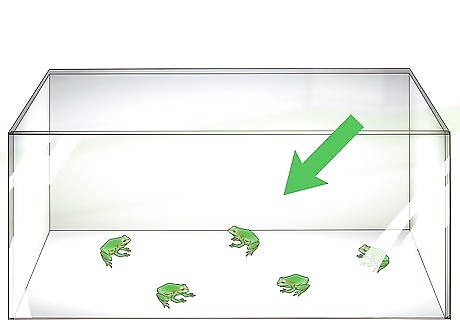
House 3 to 5 Pacific tree frogs together. Pacific tree frogs are naturally very social animals, so they will love having tank mates rather than living alone. Choose frogs of the same breed and only opt to have frogs of both genders if you are comfortable breeding them. Be aware that adding more frogs to your tank will increase the amount of food you need to provide them, as well as the frequency with which you need to clean out the tank.
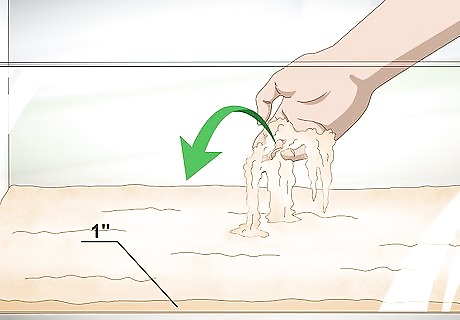
Line the tank with roughly 1 inch (2.5 cm) of a substrate material. Substrate is the lining or “carpet” that your frog can rest on in the tank. There are natural substrates, such as ones made of coconut fiber or soil, as well as artificial ones that more resemble Astroturf. Purchase a substrate material from your local pet store and use it to line around 1 inch (2.5 cm) at the bottom of the tank. If you choose a natural substrate, make sure you do not pick one made of gravel, sand, or anything else harsh. Your frog may try and swallow the substrate, so hard materials may hurt it. You can also use some types of store-bought moss, fertilizer-free potting soil, or shredded leaves as a substrate material. The substrate will make the tank more comfortable for the frog, as well as helping keep the tank humid, and absorbing some of their waste.

Provide logs, branches, and rocks for your frog to climb on. Pacific tree frogs are named for their tree-dwelling nature and their love of climbing things. To make your frog feel more at home in the tank, put in some small plants, twigs, rocks, branches, or even logs. Your frog will climb on these or hide under them, just like it would in nature. Artificial plants are much easier to maintain than real plants or logs. Ask at your local pet store to find some artificial plants you can use to decorate your frog's tank. If you bring in natural decorations from the outdoors, choose things that come from the frog’s natural habitat.

Give your frog plenty of non-chlorinated water to sit in. Your frog will need to spend a lot of time sitting in water, absorbing it through its skin to stay hydrated. Fill a large dish with filtered water, or tap water that has been treated with a dechlorination tablet, and place it in the tank. Make sure the water dish you add won’t be knocked over by your frog. Many pet stores sell water dishes designed specifically for frogs and toads, which look like small ponds or lagoons. The dish should cover around 1/3 of the frog's enclosure, to ensure it has plenty of water to sit, soak, and swim in. Most tap water has small amounts of chlorine in it, which is toxic to frogs. Make sure you only use filtered water, bottled water, or tap water that has been treated with a dechlorination tablet.
Maintaining the Habitat
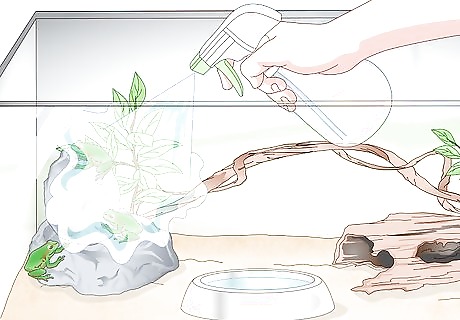
Mist the frog and its habitat daily with filtered, bottled, or treated water. While your Pacific tree frog gets most of its water from soaking, it won’t always be smart enough to hop over to the water when it’s dehydrated. Use a fine spray bottle filled with filtered water to spray down your frog and the inside of its tank each day to keep it moist. Pacific tree frogs thrive best in a very humid environment, around 70% humidity. If you can’t maintain this level of humidity, look online or ask at your local pet store about a terrarium humidifier that will help keep your frog happy. Purchase a hygrometer to attach to the tank so that you can monitor the humidity more closely. Tank or terrarium hygrometers should be available online or at your local pet store. Make sure the spray bottle is filled with filtered water, bottled water, or treated tap water. The chlorine in tap water is toxic to frogs and may make your frog sick.
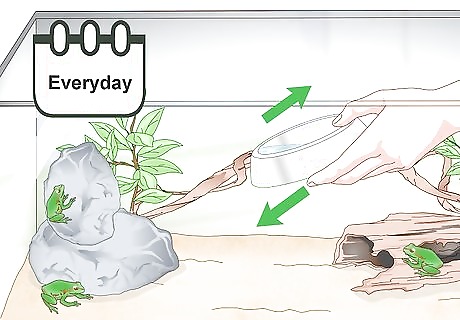
Change the water every day. As your frog spends a lot of time in the water in its tank, it will often defecate or bring substrate into the water that can muddy it. Each morning, lift the dish of water out of the tank, pour it away outside, and refill it with filtered or bottled water. This will make sure your frog always has safe, clean water to sit ion. If the water still looks clean when you go to change it, it should be OK for another day or so. If you have more than 1 frog in your tank, the water will need changing more often. You can also refill your frog's water with tap water that has been treated with a dechlorination tablet.

Attach a thermometer to the tank to monitor its internal temperature. Purchase a terrarium or tank thermometer and attach to the outside of the glass. Check the thermometer at least once each day to make sure the inside of the tank remains between 45–60 °F (7–16 °C). If you notice that the temperature inside the tank is lower than it 45 °F (7 °C), purchase an electronic heating pad to sit under one side of the tank to keep it warm. Pads designed for tree frogs should be available online or at your local pet store. Thermometers designed to attach to the glass of a tank or aquarium should be available online or from your local pet store.

Clean the tank thoroughly at least once a month. Transfer the frog to a small holding tank with some clean water and remove everything else from the tank. Scrub down the sides of the glass with filtered, bottled, or treated water to clean it, wipe down any decorations in the tank, and clean the water dish. Let everything dry fully before reassembling the tank and returning your frog to it. Don’t use any chemicals when cleaning the tank, as even residual chemicals can burn your frog's skin. If you use a natural layer of substrate, you should remove it and replace it with new substrate every month as well. This will help get rid of any waste that settles into the substrate. Wear gloves when cleaning the tank to avoid touching anything that could make you sick.
Feeding Your Frog
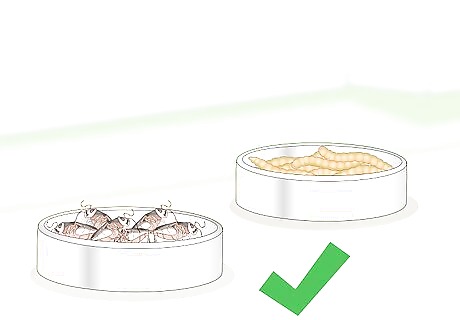
Purchase live bait, crickets, or other insects for your frog. In the wild, Pacific tree frogs are used to having to catch insects for food, so your frog likely won’t eat if it’s fed something that’s already dead or not moving. Purchase some live crickets, small worms, or other living insects to feed your frog. Don’t feed your frog anything larger than the distance between its eyes. Frogs will try and eat anything, but if it tries to eat something too big it may choke. Live frog food should be available from your local pet store. Alternately, you can try raise your own crickets to feed your frog with. You could catch insects from outside to feed to your frog, but these may be infested with parasites or pesticides that can harm your frog. If you’re squeamish about feeding your frog live insects, a Pacific tree frog might not be the right pet for you.

Feed your frog 2 to 3 times each week. Once your frog reaches its full maturity, it will only need to eat 2 or 3 bigger meals each week. Feed your frog 4 or 5 insects every couple of days, feeding it different insects when you can to vary your frog’s diet. Pacific tree frogs that have just grown from tadpoles into frogs will eat frequently but only need very small meals. When your frog is 2-3 months old, you can begin feeding it bigger meals less often. Aim for 2 or 3 insects, 2 to 3 times each week. Pacific tree frogs reach maturity after around 2 years. They’ll usually be 1 ⁄2 to 2 inches (3.8 to 5.1 cm) when they are fully grown.

Sprinkle your frog's food with a supplement on every 3rd or 4th feeding. To make sure your frog is staying healthy, you can enhance its nutrition by giving it vitamins and nutrients it may be missing. Look online or ask at your local pet store for a vitamin supplement designed for Pacific tree frogs. Sprinkle a pinch of the supplement over your frog’s food before every 3rd feeding. The most common supplements for Pacific tree frogs will include calcium, D3, and multivitamins. You should only need a tiny amount of supplement powder for every 3rd or 4th feeding, so a small jar should last a long time.

Take your frog to the vet if they stop eating. It's quite difficult to tell when your frog becomes ill, but a lack of appetite, or your frog not moving to catch its prey, is a telltale sign that something is wrong. Watch your frog for a few minutes after you feed it. If it doesn't eat or moves very slowly to catch food, take it to your local vet. Some veterinarians may not be experienced in caring for amphibians and may not be able to help you. Try and find a vet with experience in caring for exotic pets or amphibians for the best results. If you notice any sores or wounds on your frog, take it to the vet immediately. This is also a clear sign that something is wrong.












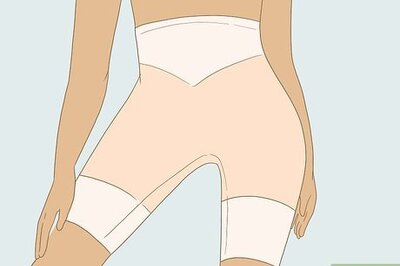
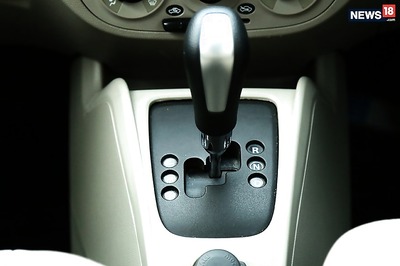





Comments
0 comment